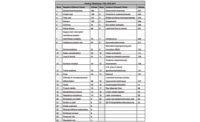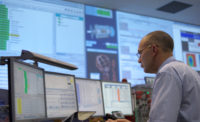The Data Boom: How New Software Solutions Are Boosting Companies’ Visibility, Quality, and Productivity
MS Companies is leveraging the gig economy to deliver a data-driven, on-demand workforce to more than 600 U.S. manufacturing companies, and Zeiss facilities are more interconnected than ever.

Millennials are transforming the manufacturing industry with big ideas and Big Data. Source: MS Companies

The new manufacturing force is data-driven and tech-savvy. Source: MS Companies

Zeiss opened a new car body and automation inspection center in Michigan. Source: Carl Zeiss Industrial Metrology

MS Companies provides a proprietary system of software and applications for manufacturing companies looking to leverage the gig economy. Source: MS Companies




In the manufacturing world, the buzzword “Industry 4.0” is on seemingly everyone’s lips for a reason. Not only do manufacturers have to keep up with rapidly evolving technology, but also with the changes in consumer trends that go along with it in order to survive, much less triumph, in an increasingly competitive and high-tech marketplace.
The average consumer relies on cloud-based communication and uses Big Data to solve problems on a regular basis, whether it’s through the use of smart phone apps in their personal lives or through more complex cloud computing software in the workplace. As a result, most manufacturing companies have instituted cloud computing and Big Data to not only elevate their quality management systems, but also reflect this cultural shift that has been ushered in by a new, tech-savvy workforce of 18-to-30-year-olds who either scarcely remember life before the Internet or have never lived without it.
What’s more, the millennial generation has already revolutionized manufacturing in two significant ways. The first is in connecting shop floor stations in a similar manner to how most of our digital devices are connected today; The second is in building and fueling what has become known as “the gig economy”: a data-driven, temporary (or project-based) employment model that drives mega-successful businesses like Uber and Airbnb—and now, 600 manufacturing companies and counting.
How Data Runs a Smart Facility in 2017
In late 2016, Carl Zeiss Industrial Metrology opened a high-tech facility in Wixom, MI, dedicated to the latest developments for the process chain in car body metrology and automated inspection. Zeiss PiWeb software, a scalable IT solution for quality data management, connects each station, combining measurement data from multiple systems into graphical part stories, SPC charts, quality documents, and customizable dashboards. Through PiWeb, a customer can organize the information flow resulting from Industry 4.0 by easily filing all required data into one report, and thus enhance the quality of their products and their overall productivity.
According to Zeiss software project manager Scott Lowen, PiWeb collects data from all inspection equipment into a single database on the customer’s server. From there, the software allows the individuals to design their own reports, or use any one of the existing reports in a library that Zeiss provides. “This allows the customers to use efficient data mining tools to do their own studies and solve their own problems,” Lowen explains. “The customer defines their own dashboard and how it behaves; so, it’s not just about seeing live data, but also being able to pinpoint an area of concern and look at the historical data to figure out what the problem is and how to fix it—and this all comes from the same environment.”
In addition to providing customers with real-time data collection software that can be tailored to suit the customers’ specific needs and provide them with increased visibility and transparency, Zeiss is raising their own company profile with open facilities like this one where customers—or potential hires—can come in and see for themselves how the software collects data and essentially runs the place.
According to Bob Wasilesky, Zeiss’ key account manager for automated inspection, even the design of this new center “focuses on learning, with dedicated stations highlighting the interaction of Zeiss technologies in the process chain.” Plus, with engineers on hand to show the benefits of these technologies and provide consulting, custom programming, and specialized training, the implication is that a new, hyper-connected manufacturing world is opening up for anyone willing to give it a try. And that’s where the gig economy comes in.
The Benefits of Workforce Matching and Mapping
MS Companies is one of the fastest-growing privately held firms in the United States; and after chatting with CEO and founder Peter Butler, it’s easy to understand why. An ISO 9001:2008 certified company, MS Companies uses proprietary WaaS (Workspace as a Service) applications to offer a gateway to a quick-response talent pool that has been trained, screened, and scaled to fit the employer’s precise needs. From digital talent acquisition to centralized scheduling, the company’s platform provides an end-to-end talent solution based on real-time data and mobile engagement, in which employers can scale their workforce up and down and have real-time visibility to the data and metrics that mean the most to them, with the flexibility to expand contract operations as needed. “What we literally do,” Butler tells me, “is help give quality-specific manufacturers quality assurance by matching them with the right people, processes, and systems to create communication and transparency, and to look at data to solve problems.”
Currently, MS Companies sources on-demand employees to hundreds of U.S. manufacturing companies of all sizes across 14 states. However, its 20 biggest customers are Fortune 500 companies that need help correcting quality control problems, dealing with generational issues in the workplace, and figuring out how to hire millennials.
“We use our proprietary system to leverage social media as a means to communicate not only to the existing manufacturing workforce, but to a prospective workforce,” Butler explains. “We engage them, build relationships, and survey them to garner the data needed to do the actual algorithms that match skill sets to jobs. It’s similar to an Uber model, but instead, it’s a B2B solution for manufacturers. We provide the workforce matching between the employee and the employer, so it’s really a win-win.”
Butler notes that he’s seen a significant shift in manufacturing companies wanting more gig economy workers than full-time workers. “And the timing is perfect,” he adds, “because that’s what the workforce seems to want, too. It’s really the excitement of the communication tool, in being able to communicate with and educate a workforce—‘the new workforce,’ as I call it—that is outstanding, because efficiency and productivity are going through the roof, along with flexibility.”
Plus, by mapping companies’ workforce DNA, software like MS Companies’ can distinguish inefficiencies and workforce gaps while also identifying employees most likely to meet the unique demands of customers’ worksites. “The nature of quality in our business model, which is about 50 percent of the overall makeup of our business, is very transient,” Butler attests. “Our footprint in the central United States, Mexico, Canada, and [soon] Europe provides the freedom and flexibility for people to travel if they want, do different projects, and get different kinds of exposure.”
Butler also underscores the importance of direct, real-time communication in the gig-economy business model.
“Each one of our workers has an employee engagement app that gives them full transparency on everything, and it’s matched with an employer engagement app,” Butler explains. “So, if there’s any dispute, the apps can talk to each other to solve the problem.”
Planning for the Future
According to a 2010 study by the software company Inuit, more than 40 percent of Americans will be independent contractors by 2020. That’s more than 60 million people. Butler provides a case study to accentuate the point, saying: “One of the largest Fortune 500 companies called me recently and said they wanted to increase their manufacturing spending by outsourcing, simply to the gig economy, by $300 million in 2017.”
In regard to the anticipated manufacturing skills gap dilemma—according to 2015 report by Deloitte, nearly 3.5 million manufacturing jobs will need to be filled over the next decade, and the skills gap is expected to result in two million of those jobs going unfilled—Butler believes that Big Data will be the solution. The more you know about your employees through data collection, he notes, the more you’ll know about the skills they already have and the skills they still need to acquire.
“If you don’t know the baseline of what the new workforce is actually capable of, or where they culturally come from, then it’s hard to do the right job-matching from the start,” he insists. “You need to have the data available to qualify workers—to be able to ask them questions and build relationships by leveraging social media, and leveraging the proprietary system that we provide —and be talking to these people continuously so we actually know, versus guess, what skills they have.”
To help rectify this potential problem, MS Companies offers a three-level quality curriculum and Six Sigma Green Belt training online, which then categorizes potential workers based on skill level and acumen. “Stackable certificates and skill sets are the future,” Butler says. “Associate degrees don’t matter as much anymore, because most manufacturing employers are only really interested in finding the specific skill set they need for a particular job.”
It’s a huge paradigm shift that companies like Zeiss are capitalizing on, and firms like MS Companies are pushing, as technology continues to progress.
“Manufacturing today is more high-tech than ever,” Butler continues. “So, if you’re not leveraging the gig economy or recruiting millennials to fill that technology gap, then not only are you going to be less efficient, but you’re missing the boat by trying to retrain people who just aren’t going to adapt to the new technology.” What he calls the “entitlement” model—how long you’ve been at the company, what generation you are, etc.—has dissipated. “Nobody cares about that,” Butler says, “which is why the gig economy is so important: It provides the authenticity that the millennials want, and what employers are starting to want more of, too.”
“The key,” Butler concludes, “is combining the two—manufacturing employers and employees—through data, so they can feed off each other to create excellence.”
Looking for a reprint of this article?
From high-res PDFs to custom plaques, order your copy today!










